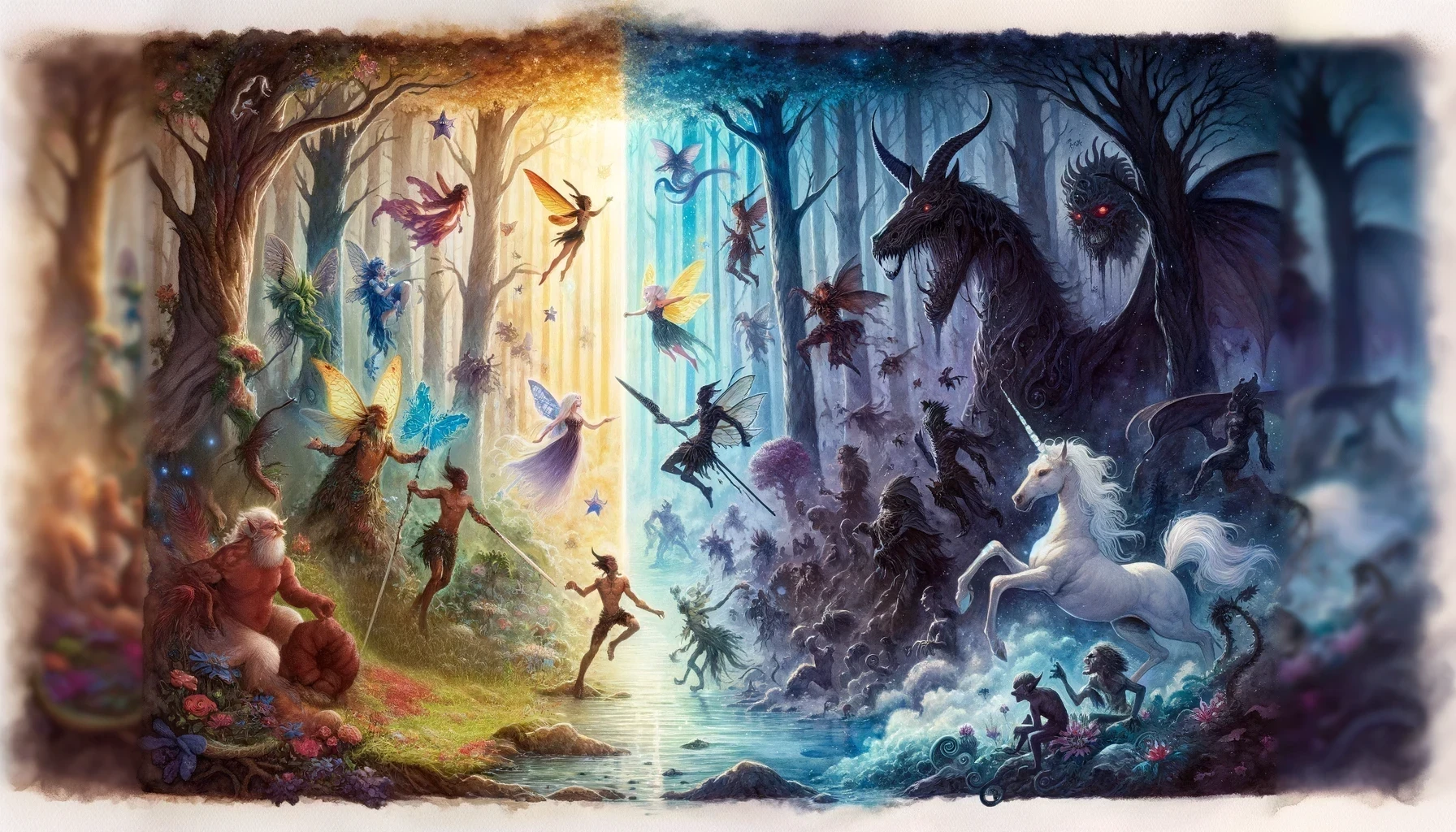top of page

The Clockwork Conspiracy
A busy steampunk cityscape scene



The Clockwork Conspiracy
A busy steampunk cityscape scene
1/4
D&D Ki
Glossary Entry: Ki
Related: Monk, Ki Points, Martial Arts, Unarmored Movement, Unarmored Defense, Stunning Strike
Classification: Game Mechanic
Definition
Ki is a type of mystical, life-sustaining energy that is used by Monks in Dungeons & Dragons (D&D). It is considered a fundamental force that flows through all living beings in the universe, according to the game lore. This concept is heavily influenced by eastern philosophies and martial arts.
In D&D game mechanics, Ki is a pool of points that a Monk character has access to, allowing them to perform special abilities beyond the standard actions available to most characters. This resource is a core aspect of the Monk class, reflecting their training and inner spiritual power.
Usage
A Monk's total Ki points are equal to their Monk level, and they replenish these points after a short or long rest. Ki points are expended to fuel various Monk abilities. These include, but are not limited to, the following:
-
Flurry of Blows: After making an attack, a Monk can spend 1 Ki point to make two additional unarmed strikes as a bonus action.
-
Patient Defense: By spending 1 Ki point, a Monk can take the Dodge action as a bonus action on their turn.
-
Step of the Wind: A Monk can spend 1 Ki point to take the Disengage or Dash action as a bonus action, and their jump distance is doubled for the turn.
-
Stunning Strike: Starting at 5th level, when a Monk hits another creature with a melee weapon attack, they can spend 1 Ki point to attempt a stunning strike.
Origin
The term "Ki" and its conceptual basis originate from eastern philosophies and martial arts. In these contexts, Ki (also spelled "Chi" or "Qi") represents a life force or energy flow. In the D&D universe, this concept is adapted to create the unique features of the Monk class.
Related Terms
-
Monk: The character class that uses Ki points to power their unique abilities.
-
Ki Points: The Monk's resource for using their special abilities. They gain a number of Ki points equal to their Monk level and regain spent Ki points after a short or long rest.
-
Stunning Strike: A feature gained by Monks at 5th level, allowing them to potentially stun an opponent by spending Ki points.
Monastic Tradition: Way of the Animal Spirit
Monks who follow the Way of the Animal Spirit have learned to channel their Ki into emulating the strengths of various animals. Through deep meditation and rigorous training, these monks harness the essence of the natural world, bringing the power and versatility of different animals into their martial arts.
Class Features of the Monk: Way of the Animal Spirit
1st Level: Spirit Animal Initiation
Upon choosing this monastic tradition at 1st level, you meditate and form a spiritual bond with an animal archetype, gaining its blessing. Choose one of the following animals: Tiger, Crane, or Snake. Each of these animal archetypes provides the following benefits:
-
Tiger: Your unarmed strikes deal an extra 1d4 damage. This increases as you gain monk levels, becoming 1d6 at 5th level, 1d8 at 11th level, and 1d10 at 17th level.
-
Crane: You gain an AC bonus equal to your Wisdom modifier while you are unarmoured and not wielding a shield or a weapon. Additionally, you can use your bonus action to take the Disengage action, similar to the Step of the Wind feature, but without spending any Ki points.
-
Snake: Once per short rest, you can make a touch attack as part of your action, dealing poison damage equal to your monk level. The targeted creature must make a Constitution saving throw or be poisoned until the end of its next turn.
3rd Level: Animal Aspect
At 3rd level, you can spend 2 Ki points to channel the essence of your chosen animal, gaining a unique power:
-
Tiger's Pounce: As part of your action, you can make a long jump equal to your monk level in feet without requiring a running start. If you land within 5 feet of a creature, you can make an additional attack as a bonus action.
-
Crane's Flight: You gain the ability to move across vertical surfaces and across liquids without falling during your move. Additionally, as a bonus action, you can spend 1 ki point to gain a flying speed equal to your movement speed until the end of your turn.
-
Snake's Strike: When you hit a creature with an unarmed strike, you can spend 1 ki point to attempt a venomous strike. The creature must succeed on a Constitution saving throw or take poison damage equal to your monk level and be poisoned until the end of its next turn.
6th Level: Beast's Resilience
At 6th level, your deep connection with your chosen animal enhances your vitality. Whenever you roll for hit points when levelling up, you can reroll any roll of 1 or 2 once, taking the new result even if it is another 1 or 2.
11th Level: Animal Transformation
At 11th level, you gain the ability to transform partially into the animal you're bonded with. As a bonus action, you can spend 3 Ki points to gain the following benefits for 1 minute:
-
Tiger Form: You grow claws and fangs, your unarmed strikes count as magical for the purpose of overcoming resistance and immunity to non-magical attacks and damage, and you gain an extra attack as part of your Attack action.
-
Crane Form: You grow large, feathered wings. You gain a flying speed equal to your movement speed and your jump height doubles.
-
Snake Form: Your body becomes serpentine, gaining advantage on Dexterity (Acrobatics) checks and saving throws, and immunity to being poisoned.
17th Level: Master of the Wild
At 17th level, you achieve mastery over your animal form and the flow of Ki within you. You can now spend 5 Ki points to transform into your spirit animal fully for 1 hour. You can use this feature once, and regain the ability to do so after a long rest.
In this form, you gain the stats and abilities of the chosen animal as stated in the Monster Manual, adjusted by your DM. However, you retain your Intelligence, Wisdom, and Charisma scores, along with your alignment and personality.
Ki in Dungeons & Dragons: Q&A
Q1: What is Ki and how is it used in the monk class?
A: Ki is a form of mystic energy that monks use to power their special abilities in Dungeons & Dragons. A monk's ki pool contains a number of Ki points equal to their monk level, and they regain spent points after a short or long rest.
Q2: How does the number of ki points a monk has change as they level up?
A: As the monk gains class levels, their number of Ki points increases. At 2nd level, a monk has 2 Ki points, and this number increases by one with each level the monk gains, up to a maximum of 20 Ki points at 20th level.
Q3: How does the power of Ki change at higher levels?
A: At higher levels, the monk's mastery of Ki allows them to use their Ki points for more powerful abilities. For example, at 5th level, monks gain the Stunning Strike feature, which allows them to spend 1 Ki point to potentially stun a creature they hit with a melee weapon attack.
Q4: What are some ways a monk can use Ki for attack rolls and damage rolls?
A: Monks can spend Ki points to make additional attacks through the Flurry of Blows ability or to increase their damage with abilities like the Ki-Empowered Strikes, which lets a monk's unarmed strikes count as magical for overcoming resistance and immunity to non-magical attacks and damage.
Q5: How does Ki interact with magic items and magical effects?
A: Ki is a form of mystical energy, but it is not inherently magical. However, some monk abilities can interact with magic. For example, the Ki-Empowered Strikes ability makes a monk's unarmed strikes count as magical for overcoming resistances and immunities. Magic items that enhance a monk's Wisdom, Dexterity, or Constitution can indirectly affect a monk's ki abilities by increasing the monk's saving throw DCs or the number of hit points they have.
Q6: What happens if a monk's Ki pool is depleted?
A: If a monk's Ki pool is depleted, they cannot use features that require Ki points until they complete a short or long rest, at the end of which they regain all their spent Ki points. They can still use other monk abilities that don't require Ki, such as Martial Arts or Unarmoured Defence.
Q7: How does the use of Ki points relate to a monk's armor class and attack modifiers?
A: Ki points do not directly affect a monk's armour class or attack modifiers. However, several monk abilities that utilize Ki, like Patient Defence, can indirectly increase a monk's defensive capabilities by allowing them to Dodge as a bonus action.
Q8: Can other classes use Ki points?
A: As of my knowledge cut off in September 2021, only the Monk class uses Ki points as part of their class features in the official Dungeons & Dragons 5th Edition rules.
Q9: Can a monk use Ki points to enhance their use of weapons?
A: Yes, some monk abilities, such as the Kensei's Path from the Way of the Kensei monastic tradition, allow monks to use Ki to enhance their use of certain weapons.
Q10: What are some optional class features related to Ki in the Monk class?
A: As of my knowledge cutoff in September 2021, optional class features that utilize ki include features from different Monastic Traditions like the Way of the Astral Self and the Way of the Sun Soul, each providing different ki-powered abilities. Consult with your Dungeon Master and the latest rulebooks for more recent updates or optional features.
Note: These class features are meant to be used with the 5th Edition Dungeons & Dragons ruleset, and may require additional refinement and balancing. Please consult with your Dungeon Master before adding this Monastic Tradition to your game.
bottom of page




